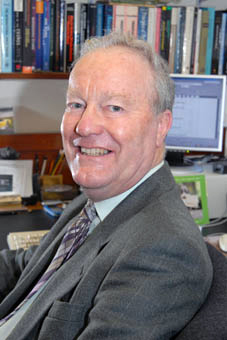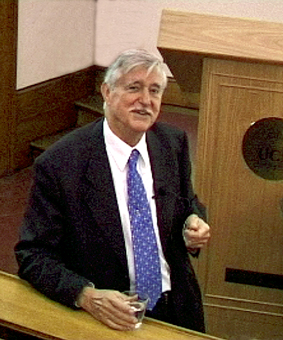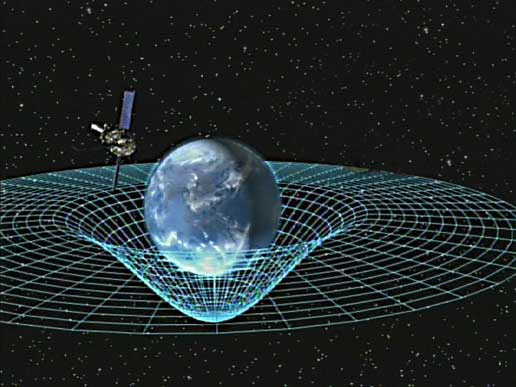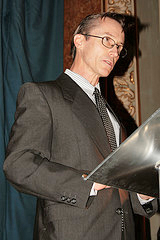Gravity Probe B and Related Matters
by Wal Thornhill | September 5, 2011 12:41 am
The following article is by Jeremy Dunning-Davies, Senior Lecturer in Physics at the University of Hull and member of the Royal Astronomical Society and Natural Philosophy Alliance.
 [1]
[1]
In a posting on the Thunderbolts web site on June 6th[2], Mel Acheson commented on the recent claims of finding a spiral galaxy in the southern skies which looks remarkably like the Milky Way, but double its accepted size. The article rightly draws attention to the fact that both the size of this galaxy and its distance from us are determined by utilising red-shift data. It is pointed out, quite correctly, that ‘the result is as certain as mathematics can be’. However, this is followed by the observation that everything based on red-shift measurements must be in doubt. The problems associated with the interpretation of any red-shift data have been around for many years but have been consistently buried under the proverbial carpet. The careers of several people, notably Halton Arp, have been disrupted if not actually ruined because they have questioned the validity of the conventional interpretation of this type of data.
 [3]
[3]This is a sad, if not disgraceful, story and would be disgusting if it was an isolated case in this truly fascinating subject of astronomy/astrophysics. Unfortunately, it is not an isolated case; it is one of many.
However, no sooner had one had time to digest the contents of this article than one was greeted by the eye-grabbing headline – ‘Gravity probe shows Einstein got it right again’ – in the June issue of Astronomy and Geophysics, the house journal of the Royal Astronomical Society. The said article appeared in the News section and claimed the NASA mission involved ‘was to carry out the most sensitive test yet of general relativity’ and it had concluded that ‘Einstein was right’. One immediately wondered to what the word ‘again’ referred precisely but, on reading the article, I was struck by some of the data quoted: it is apparently one of NASA’s longest running projects[4], the idea first being proposed in 1959 and initial funding coming in 1963. It has involved more than 100 postgraduate students and 350 undergraduates. One immediately wonders about the total cost and, also, how much indoctrination of potentially good scientists has been achieved. Over the period involved, the sum of money involved must have been considerable and, when one then contemplates all the other high-profile, expensive experiments, such as the Large Hadron Collider and LISA, being run at the present time, one ponders yet again the wisdom of all this enormous expenditure. Then one looks at the claim that ‘the probe measured the misalignment of the gyroscope spin axis and the reference star to a startling precision of 0.0005 arcsec’, and wonders. Some figures here and in other experiments also raise the query about the position of the actual boundary between noise and genuine physical effect. In fact, does such a boundary exist and, if so, is it one which moves over time as measurement techniques improve? However, all these projects have one thing in common; they all conform to present-day conventional scientific wisdom and therein, in my view, lies one of the problems.
 [5]
[5][But as a natural philosopher asked, “If time is a dimension, point me in the direction of time? -WT]
As is explained on the official NASA web page[6]:
… this experiment, launched in 2004, used four ultra-precise gyroscopes to measure the hypothesized geodetic effect, the warping of space and time around a gravitational body, and frame-dragging, the amount a spinning object pulls space and time with it as it rotates. Gravity Probe B determined both effects with unprecedented precision by pointing at a single star, IM Pegasi, while in a polar orbit around Earth. If gravity did not affect space and time, Gravity Probe B’s gyroscopes would point in the same direction forever while in orbit. But in confirmation of Einstein’s theories, the gyroscopes experienced measurable, minute changes in the direction of their spin, while Earth’s gravity pulled at them.
It might be noted that, in this NASA document, reference is continually made to space and time, rather than to space-time and in order to illustrate ideas to the uninitiated, one of the principal investigators, Francis Everitt, said, “Imagine the Earth as if it were immersed in honey. As the planet rotates, the honey around it would swirl, and it’s the same with space and time”.
A useful analogy? Possibly, but it very definitely refers to a happening in everyday three-dimensional space which occurs over time. It would seem that, if there were any frame dragging here, it would refer to the frame, fixed in the moving body comprising the usual coordinate axes, being dragged through the honey. Is this the same thing as that to which the experiment refers? If so, why all the talk of space-time? However, more of that when, for this particular example of Gravity Probe B, it is wondered what scientific queries come to the mind of an admitted sceptic as far as modern scientific conventional wisdom is concerned?
The first paragraph of the RAS report summed it all up. Primarily, it was, as mentioned already, to carry out the most sensitive test of general relativity. The remainder of that first paragraph went on to say that ‘the team measured the predicted distortion of space-time around Earth from the mass of the planet, and demonstrated that the rotation of the Earth does indeed twist space-time, causing frame dragging’. The uninitiated are probably impressed immediately but anyone with a modicum of appropriate knowledge might well ask ‘But what is space-time and what frame is being dragged?’ This seems a good, relevant question, particularly in view of earlier comments made here. In truth, space-time is a purely mathematical construct. It is a four-dimensional mathematical space in which three of the axes represent our familiar spatial coordinates and fourth axis represents time. The four axes are mutually perpendicular to one another and this, in itself, indicates the entity to be a mathematical concept rather something genuinely physical. Hence, any point in such a space does tell the observer where a body is at a particular time and the name ‘space-time’ does seem eminently appropriate – but the space is mathematical; it is not reality as we know it in our everyday lives. Once this question concerning the meaning of the word ‘space-time’ is answered, the follow-up question must be ‘What is the metric (where by metric is meant the square of the distance between two neighbouring points in the space) considered here?’
 [7]
[7]In general relativity, the Einstein field equations form the starting point for almost everything but there are several solutions to these equations. The first, and the one about which we often hear mention, was due to Karl Schwarzschild. For Gravity Probe B, it emerges that the basic work was due to Leonard Schiff and was published in Physical Review Letters in 1960 (volume 4, pages 215-7) and, probably as expected, the Schwarzschild metric was involved. However, which form of that metric was used, the original or the later modified version? This is an extremely important query because, as has been pointed out on several occasions by both myself and Stephen Crothers, the version of the Schwarzschild metric that appears in almost all modern texts is not the version which appears in the original paper. It might be wondered also if using this metric is correct in any case. What is implied physically by assuming this particular metric? One has to look very carefully at any assumptions made in deriving these expressions to see just how precisely they apply to situations under consideration. It seems that such detailed scrutiny is rarely performed and often one suspects basic results do not necessarily apply in the experimental/observational situations under consideration. As for the frame dragging, it would seem the frame to which reference is being made is that of the mathematical four-dimensional space-time and so, yet again, the person primarily concerned with what is happening in our effectively three-dimensional world must wonder what is really going on and what relevance this expensive project has to physical reality.
The other major thought to be occasioned by this news article concerns the general theory of relativity itself. Considering the time and money undoubtedly spent on this Gravity Probe B mission, it might seem inevitable to some sceptics that a positive result would have to ensue. Always remember that, in true science, a negative result can be as important, if not more important, than a positive one but to the public, which in the end pays all the bills, only positive results herald any sort of success. Be that as it may, the question of the true status of general relativity within science should be assessed. Soon after the theory first appeared, it was credited with success for solving the old problem associated with the shift of the perihelion of Mercury. But why? A satisfactory explanation had already been provided in 1898 by a German schoolteacher, P. Gerber, who published his findings in Zeitscrift für Math u Phys. (vol. 43, p 93). For some reason this seems to have been ignored even though it concerned a well-known outstanding problem and Gerber had published in a highly prestigious journal. Of course, the dubious expeditions of 1919 which led to the claim that the theory correctly predicted the bending of light rays were possibly the clincher as far as popular acclaim was concerned. However, is general relativity required to explain these phenomena? The answer is an emphatic ‘No!’ Apart from other publications by such as Harold Aspden, Bernard Lavenda eventually succeeded in publishing an article in 2005 entitled Three Tests of General relativity as Short-wavelength Diffraction Phenomena (Journal of Applied Science, vol 5, no. 2, pp. 299-308). It might be noted that this article didn’t claim general relativity incorrect, merely that there was an alternative method for obtaining various physical results. One genuinely wonders if Lavenda’s approach could be used to consider the situation examined by Gravity Probe B.
The end result, however, is that enormous sums of public money are continuing to be spent on pet projects of a select few and the contention has to be that this is retarding true progress in science. On the other hand, has a slight chink appeared in the armour? A recent BBC posting refers to the Sun emitting vast amounts of magnetically charged plasma, a great deal of which enters the Earth’s atmosphere. The short introduction actually informs the reader that, aside from the three commonly known states of matter – solid, liquid and gas – there is another state, called plasma. It seems amazing that such a statement is felt necessary in 2011 and is possibly another indication of the present state of science and popular scientific knowledge. The article then goes on to say that ‘a team of scientists at UCL’s Mullard Space Science Laboratory in Surrey is working to find out more about how the Sun’s plasma behaves and affects our planet. Dr. Lucie Green from the team – who is revealing her research at this year’s Cheltenham Science Festival – explains the properties of plasma.’ I would strongly suspect, Dr. Green might save herself a lot of time and effort as well as saving someone else a lot of money if, before proceeding with her investigations, she contacted several notable names associated with long term research into plasma cosmology and (dare I say it?) ELECTRIC UNIVERSE® ideas. When one reflects on how much information is already out there – much related to the Sun being stored in records held at Kew in London if the information in Stuart Clark’s The Sun Kings is any guide – the above apparently important scientific news item from the BBC takes on a new light and might be viewed by some as a genuine cause for worry in knowledgeable scientific circles. Have these people not heard of the work of Birkeland, Langmuir, Alfvén and Peratt, let alone such as Bruce and Juergens? If not, one may only despair even more about the inadequacies of our modern educational system. On the other hand, as indicated above, a true optimist might see the article as indicating a chink appearing in the armour of at least the British scientific establishment.
I wonder?
Jeremy Dunning-Davies
- [Image]: /wp/wp-content/uploads/2012/04/jeremy_dunningdavies.jpg
- June 6th: http://www.thunderbolts.info/tpod/2011/arch11/110606double.htm
- [Image]: /wp/wp-content/uploads/2012/04/Arp-London-2000.jpg
- longest running projects: http://einstein.stanford.edu/MISSION/mission1.html
- [Image]: /wp/wp-content/uploads/2012/04/Gravity-probe-B.jpg
- official NASA web page: http://www.nasa.gov/mission_pages/gpb/
- [Image]: /wp/wp-content/uploads/2012/04/Steve-Crothers.jpg
Source URL: https://www.holoscience.com/wp/gravity-probe-b-and-related-matters/